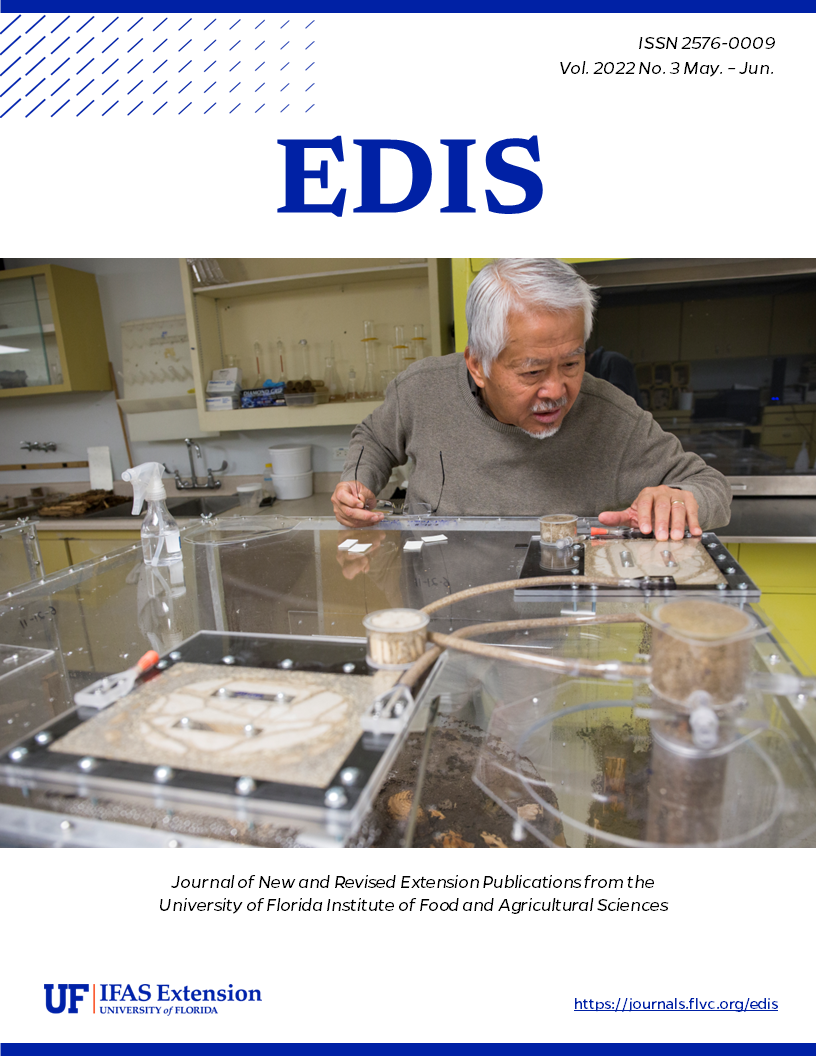Abstract
This new 5-page publication of the UF/IFAS Food Science and Human Nutrition Department provides information for the general public about the benefits of incorporating land- and water-based natural resource activities to achieve a healthy lifestyle. Written by Razieh Farzad, Brittany Scharf, Jim E. Davis, LuAnn Duncan, and Jana Anderson.
https://edis.ifas.ufl.edu/fs441
References
Allendorf, F. W., and L. L. Lundquist. 2003. “Introduction: Population Biology, Evolution, and Control of Invasive Species.” Conservation Biology 17 (1): 24–30. https://doi.org/10.1046/j.1523-1739.2003.02365.x
Bailey, R. L., K. P. West Jr., and R. E. Black. 2015. “The Epidemiology of Global Micronutrient Deficiencies.” Annals of Nutrition and Metabolism 66 (Suppl. 2): 22–33. https://doi.org/10.1159/000371618
Barré, T., M. Perignon, R. Gazan, F. Vieux, V. Micard, M.-J. Amiot, and N. Darmon. 2018. “Integrating Nutrient Bioavailability and Co-production Links When Identifying Sustainable Diets: How Low Should We Reduce Meat Consumption?” PLoS ONE 13 (2): e0191767. https://doi.org/10.1371/journal.pone.0191767
Bratman, G. N., J. P. Hamilton, K. S. Hahn, G. C. Daily, and J. J. Gross. 2015. “Nature Experience Reduces Rumination and Subgenual Prefrontal Cortex Activation.” Proceedings of the National Academy of Sciences of the United States of America 112 (28): 8567–8572. https://doi.org/10.1073/pnas.1510459112
Burns, G. W. 2005. “Naturally Happy, Naturally Healthy: The Role of the Environment in Well-being.” In The Science of Well-Being, edited by F. A. Huppert, N. Baylis, and B. Keverne, 405–434. New York: Oxford University Press. https://doi.org/10.1093/acprof:oso/9780198567523.003.0016
Church, S. P., L. B. Payne, S. Peel, and L. S. Prokopy. 2019. “Beyond Water Data: Benefits to Volunteers and to Local Water from a Citizen Science Program.” Journal of Environmental Planning and Management 62 (2): 306–326. https://doi.org/10.1080/09640568.2017.1415869
Cigliano, J. A., R. Meyer, H. L. Ballard, A. Freitag, T. B. Phillips, and A. Wasser. 2015. “Making Marine and Coastal Citizen Science Matter.” Ocean and Coastal Management 115:77–87. https://doi.org/10.1016/j.ocecoaman.2015.06.012
FAO and WHO. 2011. Report of the Joint FAO/WHO Expert Consultation on the Risks and Benefits of Fish Consumption. FAO Fisheries and Aquaculture Report No. 978. Rome.
FAO and WHO. 2019. Sustainable Healthy Diets: Guiding Principles. Rome.
FAO and WHO. 2021. The Role of Aquatic Foods in Sustainable Healthy Diets: Guiding Principles. Rome.
Hallström, E., K. Bergman, K. Mifflin, R. Parker, P. Tyedmers, M. Troell, and F. Ziegler. 2019. “Combined Climate and Nutritional Performance of Seafoods.” Journal of Cleaner Production 230:402–411. https://doi.org/10.1016/j.jclepro.2019.04.229
Heres, B., C. Crowley, S. Barry, and H. Brockmann. “Using Citizen Science to Track Population Trends in the American Horseshoe Crab (Limulus polyphemus) in Florida.” Citizen Science: Theory and Practice 6 (1): 19. http://doi.org/10.5334/cstp.385
Izenstark, D., N. Ravindran, S. Rodriguez, and N. Devine. 2021. “The Affective and Conversational Benefits of a Walk in Nature among Mother-Daughter Dyads.” Applied Psychology: Health and Well-being 13 (2): 299–316. https://doi.org/10.1111/aphw.12250
Larson, D. L., L. Phillips-Mao, G. Quiram, L. Sharpe, R. Stark, S. Sugita, and A. Weiler. 2011. “A Framework for Sustainable Invasive Species Management: Environmental, Social, and Economic Objectives.” Journal of Environmental Management 92 (1): 14–22. https://doi.org/10.1016/j.jenvman.2010.08.025
Li, Y., A. Pan, D. D. Wang, X. Liu, K. Dhana, O. H. Franco, S. Kaptoge, E. D. Angelantonio, M. Stampfer, W. C. Willett, and F. B. Hu. 2018. “Impact of Healthy Lifestyle Factors on Life Expectancies in the US Population.” Circulation 138 (4): 345–55. https://doi.org/10.1161/CIRCULATIONAHA.117.032047
Li, Y., J. Schoufour, D. D. Wang, K. Dhana, A. Pan, X. Liu, M. Song, G. Liu, H. J. Shin, Q. Sun, L. Al-Shaar, M. Wang, E. B. Rimm, E. Hertzmark, M. J. Stampfer, W. C. Willett, A. H. Franco, F. B. Hu. 2020. “Healthy Lifestyle and Life Expectancy Free of Cancer, Cardiovascular Disease, and Type 2 Diabetes: Prospective Cohort Study.” BMJ 368:l6669. https://doi.org/10.1136/bmj.l6669
Nichols, W. J. 2014. Blue Mind, the Surprising Science That Shows How Being near, in, on, or under Water Can Make You Happier, Healthier, More Connected and Better at What You Do. New York City: Little Brown Spark.
Qizilbash, M. 1998. “The Concept of Well-Being.” Economics and Philosophy 14 (1): 51–73. https://doi.org/10.1017/S0266267100004934
US Department of Health and Human Services. 2018. Physical Activity Guidelines for Americans. 2nd edition. https://health.gov/paguidelines/second-edition/pdf/Physical_Activity_Guidelines_2nd_edition.pdf
White, M. P., I. Alcock, J. Grellier, B. W. Wheeler, T. Hartig, S. L. Warber, A. Bone, M. H. Depledge, and L. E. Fleming. 2019. “Spending at Least 120 Minutes a Week in Nature Is Associated with Good Health and Well-Being.” Sci Rep. 9 (1): 7730. https://doi.org/10.1038/s41598-019-44097-3
White, M. P., L. R. Elliot, M. Gascon, B. Roberts, and L. E. Fleming. 2020. “Blue Space, Health and Well-being: A Narrative Overview and Synthesis of Potential Benefits.” Environmental Research 191:110169. https://doi.org/10.1016/j.envres.2020.110169
Wyles, K. J., S. Pahl, M. Holland, and R. C. Thompson. 2017. “Can Beach Cleanups Do More Than Clean Up Litter? Comparing Beach Cleans to Other Coastal Activities.” Environment and Behavior 49 (5): 509–535. https://doi.org/10.1177/0013916516649412

